Marine Conservation Zones have been expanded considerably around the waters of England after the Department for Environment, Food & Rural Affairs (DEFRA) added twenty-three new zones to the country’s Blue Belt. Britain’s marine wildlife is among the richest and most diverse in the world.
Now, more than twenty percent of English waters are within the Blue Belt, i.e. they are Marine Conservation Zones.
Marine Conservation Zones protect a range of nationally important marine wildlife, habitat, geomorphology and geology, and can be designated anywhere in UK offshore waters. The conservation scheme started when the Marine and Coastal Access Act 2009 became law. Lundy Island in the Bristol Channel became the first Marine Conservation Zone in January 2010.
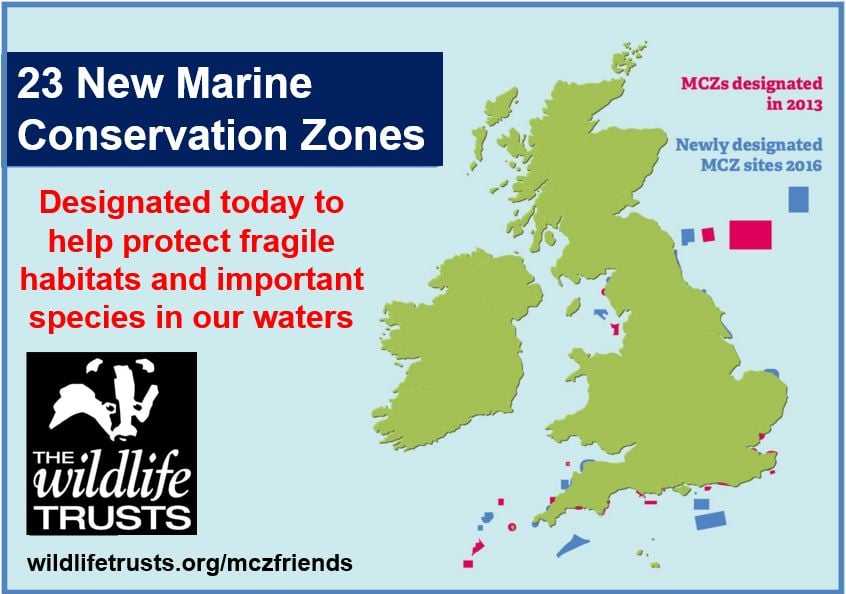 According to The Wildlife Trusts: “Marine Conservation Zones are a type of protected area at sea designated for habitats and species of national importance, including fragile seahorses, rare native oysters and even cold water coral reefs. Such protected areas are a tried and tested means of giving vulnerable species the time and space to recover.” (Image: wildlifetrusts.org)
According to The Wildlife Trusts: “Marine Conservation Zones are a type of protected area at sea designated for habitats and species of national importance, including fragile seahorses, rare native oysters and even cold water coral reefs. Such protected areas are a tried and tested means of giving vulnerable species the time and space to recover.” (Image: wildlifetrusts.org)
Protected waters expanded by 4,155 square miles
Parliamentary Under Secretary of State for Farming, Food and the Marine Environment, George Eustice, Member of Parliament for Camborne and Redruth since 2010, announced the new sites. Today, an additional 4,155 square miles of England’s most stunning and rich marine habitats will be protected.
There are today fifty Marine Conservation Zones (MCZs) in waters around England, covering a total of 7,886 square miles – an area approximately the size of Wales, or thirteen times larger than Greater London.
The new MCZs will cover areas across England as far south as Land’s End and up to Farned East off the coast of Northumberland, and will protect forty-five types of geological features, habitats and fascinating species, including spiny lobsters and stalked jellyfish.
English waters among richest and most diverse in the world
Mr. Eustice said:
“As an island nation, the UK is surrounded by some of the richest and most diverse sea life in the world – from the bright pink sea-fan coral colonies off the south-west coast, to the great chalk reef stretches in the east.”
“It’s vital that we protect our marine environment to ensure our seas remain healthy, our fishing industry remains prosperous and future generations can enjoy our beautiful beaches, coastline and waters.”
“By designating these new Marine Conservation Zones and creating a Blue Belt of protected areas around the country, we can better protect our environment through careful marine management in years to come.”
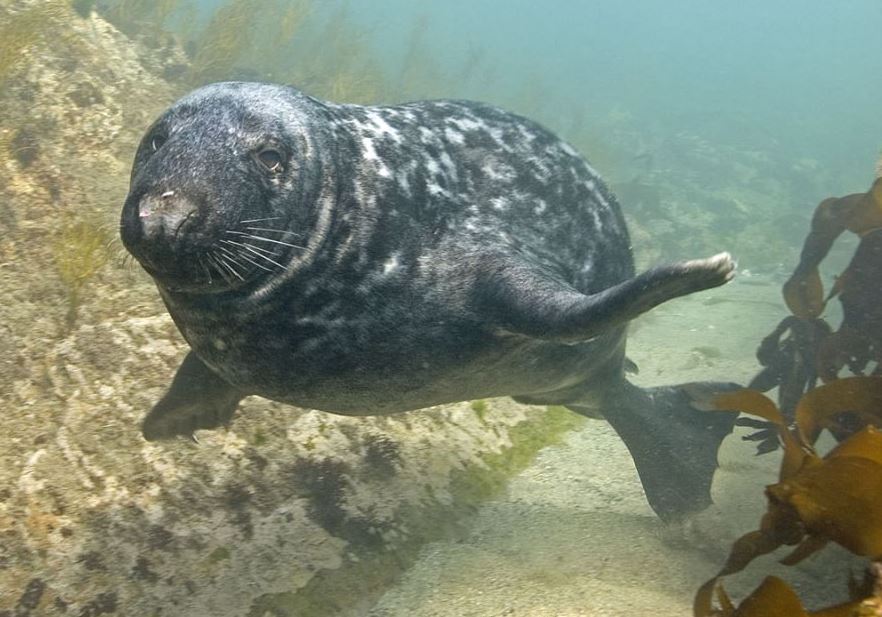 Britain’s 11,073 miles of coastline is host to many thousands of species including seals, intricate corals, whales & dolphins, basking sharks, and a myriad fascinating fish, crustaceans and molluscs. (Image: wildlifetrusts.org)
Britain’s 11,073 miles of coastline is host to many thousands of species including seals, intricate corals, whales & dolphins, basking sharks, and a myriad fascinating fish, crustaceans and molluscs. (Image: wildlifetrusts.org)
Phase II of a 3-phase plan
This new addition is the second stage of a three-phase plan of MCZs. The first phase covered an area of 3,731 square miles and included 27 sites. The third phase of proposed MCZs will be put to public consultation next year, and designated in 2018.
Several campaign groups across the country welcomed the announcement. Joan Edwards, head of Living Seas at the Wildlife Trust, said:
“Marine protection is vital to us all, no matter where we live. Our seas provide the oxygen for every second breath we take, the fish on our plates and so much more.”
“The designation of 50 Marine Conservation Zones to date is a strong step forward but there is much still to do. It is vital that appropriate management is implemented as soon as possible. We will continue to work with government to ensure that this happens and to achieve the much-needed ambitious and comprehensive third and final tranche.”
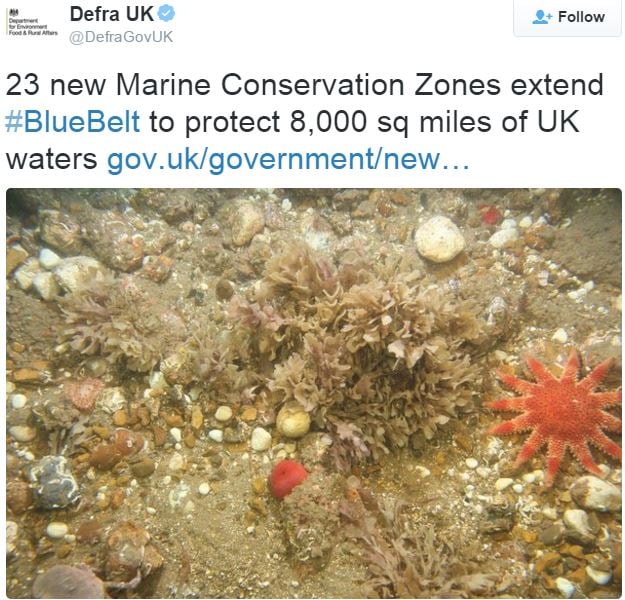 The news was welcomed by conservation groups across the UK. (Image: twitter.com/DefraGovUK)
The news was welcomed by conservation groups across the UK. (Image: twitter.com/DefraGovUK)
Marine Conservation Zones were introduced to combat the deterioration of Britain’s biodiversity and provide a legal means to deliver the country’s international marine conservation commitments.
Announcement supports other conservation work
The announcement supports further work by the Government to protect the marine environment, as new consultations on SACs (Special Areas of Conservation) for harbor porpoise and SPAs (Special Protection Areas) to protect feeding and bathing areas for a number of iconic birds, such as puffins on the Northumberland coast and spoonbills in Poole, are expected to launch later in January. This adds to the 43 SPAs and 37 SACs already designated along the English coast.
The Joint Nature Conservation Committee (JNCC) and Natural England provided the environmental evidence and advice that led to the selection of the 23 MCZs.
Andrew Sells, Chairman of Natural England, said:
“This is a fantastic outcome for the marine environment and brings us a great step closer to achieving the ambition of a ‘Blue Belt’ – a network of marine areas protecting wildlife surrounding the UK.”
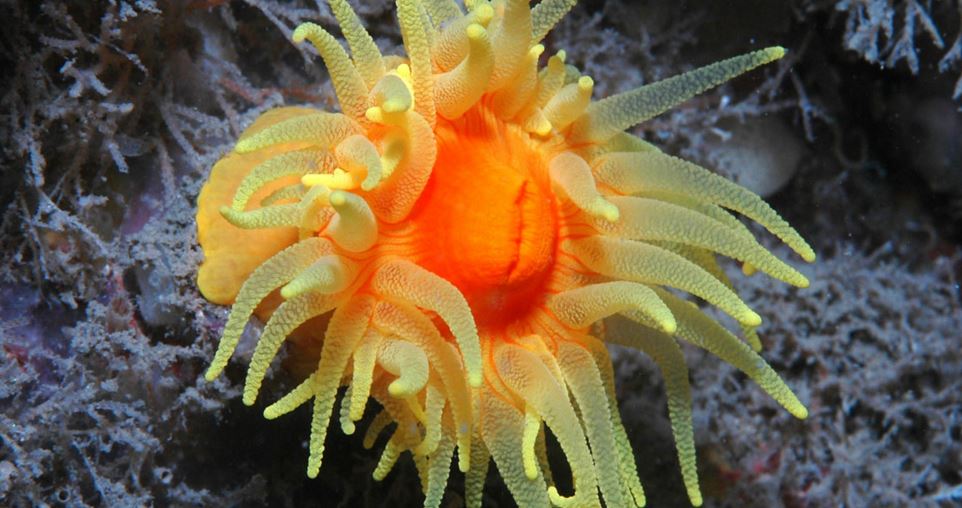 The waters surrounding Lundy Island, the first Marine Conservation Zone, boast both spectacular and often rare marine life. (Image: landmarktrust.org.uk)
The waters surrounding Lundy Island, the first Marine Conservation Zone, boast both spectacular and often rare marine life. (Image: landmarktrust.org.uk)
Marcus Yeo, Chief Executive of JNCC, said:
“This is another major step forward in protecting the diverse range of habitats and species found in the seas around England. JNCC look forward to working with public authorities to achieve effective management of the new sites.
No change until bylaws or legislation put in place
Designation and management, however, are treated as completely separate processes. This means that until legislation or bylaws have been put in place, activities in these MCZs will remain largely unchanged.
BBC News quoted Paul Trebilcock, from the Cornish Fish Producers Association, who said:
“It’s madness. A line has been drawn on a map but there is no management plan in place. No-one knows what will and will not be able to continue. The majority of fishermen rely on the marine environment being healthy to make a living – they have more interest in keeping it healthy than anybody. To hear the government drawing a line and saying it’s all fine doesn’t inspire much confidence.”
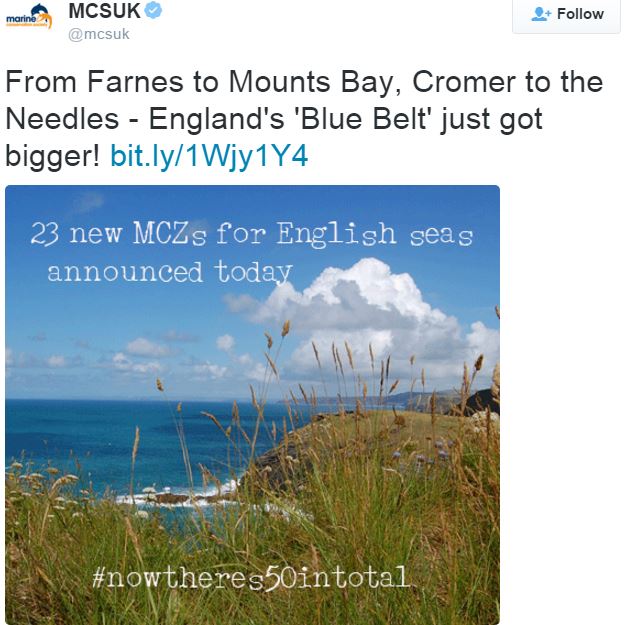 The Marine Conservation Society tweeted the above message and wrote in its website today: “A very big thank you to all of you who took part in the MCZ consultation for England in 2015. 4,789 of you responded in favour of protecting the 23 places under consultation.” (Image: twitter.com/mcsuk)
The Marine Conservation Society tweeted the above message and wrote in its website today: “A very big thank you to all of you who took part in the MCZ consultation for England in 2015. 4,789 of you responded in favour of protecting the 23 places under consultation.” (Image: twitter.com/mcsuk)
The 23 new Marine Conservation Zones are:
South East
– Dover to Deal
– Dover to Folkestone
– Offshore Brighton
– Offshore Overfalls (SE of the Isle of Wight)
– The Needles
– The Swale Estuary
– Utopia (SW of Selsey Bill)
South West
– Bideford to Foreland Point
– Greater Haig Fras
– Hartland Point to Tintagel
– Land’s End
– Mounts Bay
– Newquay and The Gannel
– North-West of Jones Bank
– Western Channel
North Sea
– Coquet to St Mary’s
– Cromer Shoal Chalk Beds
– Farnes East
– Fulmar
– Holderness Inshore
– Runswick Bay
Irish Sea
– Allonby Bay
– West of Walney co-location zone
Video – Marine Conservation Zones
This 2013 video by the Wildlife Trusts explains why Marine Conservation Zones are important.
